Trailblazing Tales: The Top 15 Hiking Movies You Must Watch

15 Must-Watch Hiking Movies
Hiking is an outdoor activity that allows you to connect with nature, challenge your physical limits, and experience breathtaking landscapes. Over the years, hiking has captured the imagination of filmmakers who seek to capture the beauty, adventure, and personal journeys that come with exploring the trails – leading to some great hiking movies.
In this article, we embark on a cinematic journey to unveil the top 15 hiking movies that every outdoor enthusiast should watch. From gripping dramas to inspiring documentaries, this collection covers a wide range of films that showcase the allure and challenges of hiking.
Within the realm of hiking movies, you’ll find tales of survival, self-discovery, and the indomitable human spirit. These hiking movies not only entertain but also provide a visual and emotional experience that resonates with both seasoned hikers and armchair adventurers alike.
From awe-inspiring vistas to intimate character-driven narratives, the films selected for this list have left an indelible mark on the hiking movie genre. Whether you’re seeking motivation for your next hiking trip or simply looking to immerse yourself in nature from the comfort of your living room, this compilation is sure to satisfy your wanderlust.
So grab your hiking boots, make yourself comfortable, and get ready to explore the best of hiking cinema. From classic masterpieces to contemporary gems, we’ll guide you through the captivating world of hiking movies, unearthing trailblazing tales that will leave you inspired and eager to hit the trails yourself.
Into the Wild
 First on our list of hiking movies is “Into the Wild” starring Emile Hirsch. “Into the Wild” is a mesmerizing cinematic journey that tells the true story of Christopher McCandless, a young man who leaves behind his conventional life to embark on a solo hiking adventure into the Alaskan wilderness. Directed by Sean Penn, this film is a thought-provoking exploration of self-discovery, freedom, and the transformative power of nature.
First on our list of hiking movies is “Into the Wild” starring Emile Hirsch. “Into the Wild” is a mesmerizing cinematic journey that tells the true story of Christopher McCandless, a young man who leaves behind his conventional life to embark on a solo hiking adventure into the Alaskan wilderness. Directed by Sean Penn, this film is a thought-provoking exploration of self-discovery, freedom, and the transformative power of nature.
The movie follows Christopher, played by Emile Hirsch, as he sets out on a quest to find meaning and authenticity in a world he perceives as artificial. With limited supplies and no map, he immerses himself in the natural beauty of the American West, encountering various individuals and forging connections along the way.
The hiking scenes in “Into the Wild” are nothing short of breathtaking. From vast deserts to towering mountains, the film showcases the stunning landscapes that Christopher encounters during his journey. The cinematography captures the rawness and grandeur of nature, making viewers feel as though they are right beside Christopher on his trek.
What makes “Into the Wild” particularly compelling is the introspective exploration of the protagonist’s inner world. As Christopher disconnects from societal norms, he confronts the true essence of his being and questions the purpose of his existence. The movie raises profound philosophical and existential questions, leaving viewers contemplating their own values and the pursuit of happiness.
“Into the Wild” is a captivating hiking movie that challenges societal expectations and delves into the complexities of human nature. It serves as a cautionary tale about the risks and rewards of venturing into the wilderness alone, as well as a reminder of the profound impact that nature can have on our lives.
Key Takeaways:
- “Into the Wild” is a true story about a young man’s solo hiking adventure into the Alaskan wilderness.
- The film explores themes of self-discovery, freedom, and the transformative power of nature.
- The hiking scenes showcase stunning landscapes and capture the grandeur of nature.
- The movie raises philosophical and existential questions about the purpose of life and the pursuit of happiness.
- “Into the Wild” serves as a cautionary tale and a reminder of the profound impact of nature on our lives.
Rent or Buy “Into the Wild” via Prime Video
Tracks
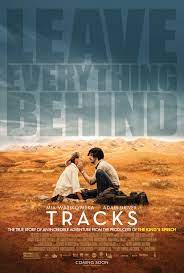 “Tracks” is a remarkable true story brought to life on the silver screen, recounting the extraordinary journey of Robyn Davidson. Directed by John Curran, this film takes viewers on a mesmerizing trek across the vast Australian desert and delves into the profound personal transformation that can occur through the act of hiking.
“Tracks” is a remarkable true story brought to life on the silver screen, recounting the extraordinary journey of Robyn Davidson. Directed by John Curran, this film takes viewers on a mesmerizing trek across the vast Australian desert and delves into the profound personal transformation that can occur through the act of hiking.
The film follows Robyn, portrayed by Mia Wasikowska, as she sets out on an audacious endeavor to walk 1,700 miles through the Australian Outback with her dog and four camels. Robyn’s ambitious goal is not only a physical challenge but also an emotional and spiritual quest to find herself and embrace solitude amidst the harsh and isolated desert environment.
“Tracks” showcases the awe-inspiring landscapes of the Australian Outback, capturing the raw beauty and harsh realities of the desert. The cinematography vividly portrays the vastness and emptiness of the terrain, immersing viewers in the sensory experience of the journey. The film beautifully contrasts the ruggedness of the environment with moments of profound serenity and connection to nature.
One of the film’s strongest aspects is its exploration of solitude and self-discovery. As Robyn traverses the desert alone, she confronts her fears, reevaluates her priorities, and gains a deeper understanding of herself and her place in the world. The movie celebrates the resilience of the human spirit and the transformative power of embarking on a solitary hiking adventure.
“Tracks” also delves into the complex relationship between humans and animals. Robyn’s companions, the camels and her loyal dog, play a significant role in her journey, symbolizing companionship, survival, and the interconnectedness of all living beings. The film beautifully captures the bond that forms between Robyn and her animal companions as they navigate the challenges of the desert together.
In the end, “Tracks” is a deeply moving and introspective hiking movie that explores themes of self-discovery, solitude, and the indomitable human spirit. It serves as a reminder of the resilience and strength we possess when faced with adversity, as well as the transformative power of immersing ourselves in the natural world.
Key Takeaways:
- “Tracks” tells the true story of Robyn Davidson’s solo hike through the Australian Outback.
- The film showcases the awe-inspiring landscapes and the harsh realities of the desert environment.
- It explores themes of solitude, self-discovery, and the complex relationship between humans and animals.
- “Tracks” captures the transformative power of embarking on a solitary hiking adventure.
- The movie celebrates the resilience of the human spirit and the profound connections found in nature.
Watch “Tracks” Now with Prime Video
The Way
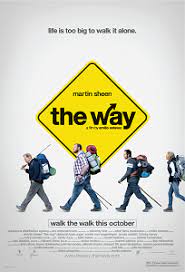 “The Way” is a poignant and heartfelt hiking movie that takes viewers on a transformative journey along the Camino de Santiago, a famous pilgrimage route in Spain. Directed by Emilio Estevez, the film follows the story of Tom, played by Martin Sheen, as he embarks on a pilgrimage to honor his late son and discovers the power of community, self-reflection, and personal growth.
“The Way” is a poignant and heartfelt hiking movie that takes viewers on a transformative journey along the Camino de Santiago, a famous pilgrimage route in Spain. Directed by Emilio Estevez, the film follows the story of Tom, played by Martin Sheen, as he embarks on a pilgrimage to honor his late son and discovers the power of community, self-reflection, and personal growth.
“The Way” begins with Tom, an American doctor, receiving the tragic news of his son’s death while on the Camino de Santiago. Struck by grief and seeking a connection with his son, Tom decides to complete the pilgrimage himself, carrying his son’s ashes along the way. As he embarks on this physical and emotional journey, he encounters a diverse group of fellow pilgrims who accompany him, each with their own unique stories and motivations.
The film beautifully captures the stunning landscapes and historic landmarks along the Camino de Santiago, inviting viewers to immerse themselves in the richness of the journey. The cinematography depicts the changing scenery, from the rugged mountains of the Pyrenees to the picturesque villages and vast open plains, showcasing the physical challenges and beauty of the trail.
One of the key strengths of “The Way” is its exploration of the themes of grief, self-discovery, and the power of human connection. As Tom interacts with his fellow pilgrims, he begins to heal from his loss and undergoes a profound transformation. The movie highlights the importance of communal support, camaraderie, and shared experiences in overcoming personal struggles and finding inner peace.
“The Way” also touches upon the spiritual aspects of the pilgrimage, exploring the diverse motivations and beliefs of the individuals who undertake the journey. It delves into the search for meaning, faith, and personal redemption that often accompanies such profound endeavors. Through Tom’s experiences and encounters, the film encourages viewers to reflect on their own life journeys and the potential for personal growth and transformation.
In summary, “The Way” is a deeply moving and introspective hiking movie that explores themes of grief, self-discovery, and the power of community. It serves as a reminder of the transformative power of embarking on a pilgrimage, both physically and emotionally, and the profound impact of human connections along the way.
Key Takeaways:
- “The Way” follows the story of Tom, who embarks on a pilgrimage along the Camino de Santiago to honor his late son.
- The film showcases the stunning landscapes and historic landmarks along the Camino, capturing the physical challenges and beauty of the trail.
- It explores themes of grief, self-discovery, and the power of human connection.
- “The Way” highlights the importance of communal support and shared experiences in finding healing and inner peace.
- The movie touches upon the spiritual aspects of pilgrimage and encourages viewers to reflect on their own life journeys.
Wild
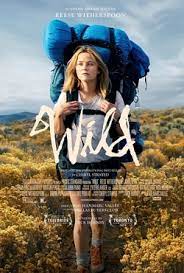 “Wild” is a captivating and emotionally charged hiking movie based on Cheryl Strayed’s memoir of the same name. Directed by Jean-Marc Vallée, the film chronicles Cheryl’s arduous journey along the Pacific Crest Trail (PCT), a challenging long-distance hiking trail that spans over 2,600 miles across the Western United States. With powerful performances and a raw portrayal of personal struggle, “Wild” explores themes of self-discovery, healing, and the transformative power of nature.
“Wild” is a captivating and emotionally charged hiking movie based on Cheryl Strayed’s memoir of the same name. Directed by Jean-Marc Vallée, the film chronicles Cheryl’s arduous journey along the Pacific Crest Trail (PCT), a challenging long-distance hiking trail that spans over 2,600 miles across the Western United States. With powerful performances and a raw portrayal of personal struggle, “Wild” explores themes of self-discovery, healing, and the transformative power of nature.
The film introduces Cheryl, portrayed by Reese Witherspoon, as she sets out on the PCT following a series of personal losses and self-destructive behaviors. With an overloaded backpack and little hiking experience, Cheryl embarks on a physically demanding and emotionally cathartic journey. As she traverses breathtaking wilderness, battles physical hardships, and encounters both kindness and danger along the way, Cheryl’s inner journey unfolds.
“Wild” expertly captures the beauty and challenges of the PCT, showcasing sweeping vistas, dense forests, and rugged mountain terrains. The cinematography draws viewers into the immersive wilderness, evoking a sense of awe and respect for the natural world. Through the visual storytelling, the film conveys the transformative impact of nature and the solace it offers to Cheryl during her most trying moments.
Central to the story is Cheryl’s personal growth and healing. As she confronts her inner demons and grapples with her past mistakes, the PCT becomes a metaphorical path of redemption. Cheryl’s physical struggles on the trail mirror her emotional and psychological journey, and viewers witness her resilience, determination, and gradual transformation into a stronger, more self-aware individual.
“Wild” also explores the concept of solitude and the importance of self-reliance in the wilderness. As Cheryl navigates the trail, she learns valuable lessons about self-sufficiency, adaptability, and finding strength within herself. The movie highlights the inherent challenges and rewards of solo hiking, emphasizing the need for introspection and self-discovery that often accompany such journeys.
Ultimately, “Wild” is a powerful hiking movie that celebrates the indomitable spirit of the human heart and the healing power of nature. It portrays the transformative potential of embarking on a long-distance hike, where the physical and emotional challenges converge to forge personal growth, self-acceptance, and a profound connection with the natural world.
Key Takeaways:
- “Wild” is based on Cheryl Strayed’s memoir and follows her journey along the Pacific Crest Trail.
- The film showcases the beauty and challenges of the PCT, immersing viewers in the stunning wilderness landscapes.
- It explores themes of self-discovery, healing, and the transformative power of nature.
- “Wild” portrays Cheryl’s personal growth and resilience as she confronts her inner demons on the trail.
- The movie highlights the importance of solitude, self-reliance, and introspection in the wilderness.
Rent or Buy “Wild” via Prime Video
The Way Back
 “The Way Back” is a gripping and emotionally resonant hiking movie that explores themes of redemption, resilience, and the power of the human spirit. Directed by Peter Weir, this film follows a group of prisoners who escape from a Siberian gulag during World War II and embark on a treacherous journey on foot to find freedom.
“The Way Back” is a gripping and emotionally resonant hiking movie that explores themes of redemption, resilience, and the power of the human spirit. Directed by Peter Weir, this film follows a group of prisoners who escape from a Siberian gulag during World War II and embark on a treacherous journey on foot to find freedom.
The movie centers around Janusz, portrayed by Jim Sturgess, who is wrongly imprisoned in the gulag for espionage. Determined to regain his freedom, Janusz joins a group of fellow prisoners, each with their own motivations and backgrounds, as they plot their escape. Together, they endure harsh weather conditions, hunger, and physical exhaustion as they trek across vast terrains, including the unforgiving Siberian wilderness.
“The Way Back” showcases the brutal beauty of nature as the prisoners traverse snow-covered mountains, dense forests, and barren landscapes. The cinematography captures the vastness and isolation of their surroundings, emphasizing the challenging and treacherous nature of their journey. The film’s visuals evoke a sense of both awe and danger, heightening the emotional impact of their struggle.
Central to the film is the exploration of human resilience and the indomitable will to survive. As the group faces numerous obstacles and hardships, they are tested physically and mentally. The movie delves into their individual stories, revealing the depth of their character and their shared desire for freedom. It highlights the strength of their camaraderie and their determination to overcome seemingly insurmountable odds.
“The Way Back” also delves into themes of personal redemption and the search for meaning in the face of adversity. The characters’ journey becomes a metaphor for their inner transformation, as they confront their past mistakes, confront their fears, and strive for a fresh start. The film explores the power of hope, resilience, and the human capacity for change.
In the end, “The Way Back” is a compelling and moving hiking movie that tells a story of survival, friendship, and the pursuit of freedom. It serves as a reminder of the strength of the human spirit and the unyielding desire to reclaim one’s life and find redemption, even in the harshest of circumstances.
Key Takeaways:
- “The Way Back” depicts a group of prisoners who escape from a Siberian gulag during World War II.
- The film showcases the brutal beauty of nature as they trek through various landscapes.
- It explores themes of resilience, survival, and the power of human connection.
- “The Way Back” delves into personal redemption and the search for meaning in the face of adversity.
- The movie celebrates the strength of the human spirit and the unwavering pursuit of freedom.
Watch “The Way Back” Now with Prime Video
Wildlike
 “Wildlike” is a captivating and poignant hiking movie that explores themes of resilience, healing, and the transformative power of human connections. Directed by Frank Hall Green, the film tells the story of Mackenzie, a troubled teenager who embarks on a life-changing journey through the rugged wilderness of Alaska.
“Wildlike” is a captivating and poignant hiking movie that explores themes of resilience, healing, and the transformative power of human connections. Directed by Frank Hall Green, the film tells the story of Mackenzie, a troubled teenager who embarks on a life-changing journey through the rugged wilderness of Alaska.
The movie introduces us to Mackenzie, portrayed by Ella Purnell, as she escapes from an abusive situation and finds herself alone in Alaska. Desperate and uncertain of her next steps, she crosses paths with Bartlett, played by Bruce Greenwood, an experienced backpacker who becomes an unlikely companion and mentor on her journey.
As Mackenzie and Bartlett venture into the remote Alaskan wilderness, the film showcases the awe-inspiring landscapes and the inherent challenges of survival. The cinematography captures the vastness and beauty of the wilderness, immersing viewers in the harsh yet stunning natural environment. Through their trek, the movie highlights the resilience and strength required to navigate and find solace in such a formidable setting.
“Wildlike” delves into the emotional and psychological transformation of Mackenzie as she confronts her past traumas and discovers her inner strength. The wilderness becomes a metaphorical backdrop for her journey towards healing and self-discovery. As she forms a deep bond with Bartlett and learns essential survival skills, Mackenzie gains a newfound sense of empowerment and resilience.
One of the film’s strengths is its exploration of the power of human connections in times of adversity. The relationship between Mackenzie and Bartlett evolves from wary strangers to a supportive and profound friendship. Through their shared experiences and genuine care for one another, they find solace, understanding, and a sense of belonging in the vast wilderness. The movie beautifully portrays the impact that meaningful connections can have on an individual’s healing and personal growth.
“Wildlike” also touches upon themes of trust, vulnerability, and the importance of finding one’s own path. Mackenzie’s journey reflects her transition from a state of fear and uncertainty to one of self-reliance and empowerment. The film serves as a testament to the resilience of the human spirit and the transformative potential of stepping outside one’s comfort zone.
In summary, “Wildlike” is a powerful hiking movie that explores themes of resilience, healing, and the profound impact of human connections. It captures the beauty and challenges of the Alaskan wilderness while delving into the personal transformation of its protagonist. Through Mackenzie’s journey, the film reminds us of the strength we possess and the transformative power of embarking on a wilderness adventure.
Key Takeaways:
- “Wildlike” follows Mackenzie, a troubled teenager who embarks on a life-changing journey through the Alaskan wilderness.
- The film showcases the beauty and challenges of the wilderness, immersing viewers in the stunning natural environment.
- It explores themes of resilience, healing, and the transformative power of human connections.
- “Wildlike” highlights the importance of trust, vulnerability, and finding one’s own path.
- The movie celebrates the strength of the human spirit and the transformative potential of wilderness adventures.
Watch “WildLike” Now with Prime Video
A Walk in the Woods
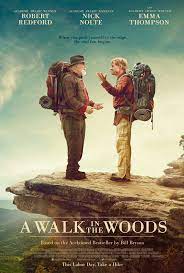 “A Walk in the Woods” is a delightful and humorous hiking movie that brings to life the best-selling memoir by Bill Bryson. Directed by Ken Kwapis, the film tells the story of Bryson’s attempt to hike the Appalachian Trail, a 2,200-mile long-distance trail that stretches from Georgia to Maine, along with his eccentric and unlikely hiking companion, Stephen Katz.
“A Walk in the Woods” is a delightful and humorous hiking movie that brings to life the best-selling memoir by Bill Bryson. Directed by Ken Kwapis, the film tells the story of Bryson’s attempt to hike the Appalachian Trail, a 2,200-mile long-distance trail that stretches from Georgia to Maine, along with his eccentric and unlikely hiking companion, Stephen Katz.
The movie introduces us to Bill Bryson, portrayed by Robert Redford, an aging travel writer who feels a strong desire to reconnect with nature and embark on a grand adventure. Despite the skepticism of his wife, Bryson sets out to hike the Appalachian Trail, but not before reconnecting with Katz, an old friend and equally spirited character played by Nick Nolte.
As Bryson and Katz journey along the trail, the film showcases the breathtaking beauty of the Appalachian Mountains, picturesque forests, and quaint trail towns. The cinematography immerses viewers in the enchanting scenery, capturing the serenity and natural wonders encountered on the journey. The film strikes a balance between showcasing the challenges of long-distance hiking and the moments of joy and camaraderie found along the way.
“A Walk in the Woods” explores themes of friendship, self-discovery, and the pursuit of adventure later in life. Bryson and Katz’s contrasting personalities and witty banter provide plenty of comedic moments, while also highlighting the complexities and rewards of forging deep connections during a shared hiking experience. The movie beautifully portrays the transformative power of stepping out of one’s comfort zone and embracing the unpredictability of the trail.
Beyond the humor, the film also touches upon the environmental and conservation aspects of the Appalachian Trail. Bryson’s journey prompts reflections on the importance of preserving nature’s beauty and the need to protect wilderness areas for future generations. The movie serves as a reminder of the fragility of our natural resources and the responsibility we have to be stewards of the environment.
In summary, “A Walk in the Woods” is a lighthearted and engaging hiking movie that celebrates friendship, adventure, and the beauty of the Appalachian Trail. It captures the stunning landscapes, humorous encounters, and personal growth experienced by its protagonists. The film serves as an inspiration for viewers of all ages to embrace the call of the wild and embark on their own transformative hiking journeys.
Key Takeaways:
- “A Walk in the Woods” is based on Bill Bryson’s memoir and follows his attempt to hike the Appalachian Trail.
- The film showcases the scenic beauty of the Appalachian Mountains and the challenges of long-distance hiking.
- It explores themes of friendship, self-discovery, and adventure later in life.
- “A Walk in the Woods” highlights the importance of preserving nature and the environmental aspects of the trail.
- The movie inspires viewers to embrace the call of the wild and embark on their own hiking adventures.
Watch “A Walk in the Woods” Now with Prime Video
Mile… Mile and a Half
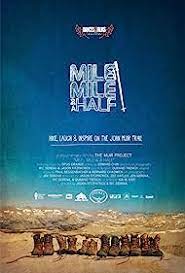 “Mile… Mile and a Half” is an inspiring and visually stunning hiking movie that documents the journey of a group of artists who embark on a 211-mile hike along the John Muir Trail in the Sierra Nevada Mountains. Directed by Jason Fitzpatrick and Ric Serena, the film offers a unique perspective on the transformative power of nature, creativity, and human connection.
“Mile… Mile and a Half” is an inspiring and visually stunning hiking movie that documents the journey of a group of artists who embark on a 211-mile hike along the John Muir Trail in the Sierra Nevada Mountains. Directed by Jason Fitzpatrick and Ric Serena, the film offers a unique perspective on the transformative power of nature, creativity, and human connection.
The movie introduces us to a diverse group of artists, including painters, photographers, musicians, and writers, who share a common love for nature and a desire to capture its essence through their respective art forms. They set out to hike the John Muir Trail, a challenging and breathtakingly beautiful trail that spans from Yosemite National Park to Mount Whitney.
As the artists journey through the rugged wilderness, “Mile… Mile and a Half” immerses viewers in the awe-inspiring landscapes of the Sierra Nevada Mountains. The film’s cinematography captures the grandeur of the mountains, pristine alpine lakes, and majestic vistas, transporting viewers to the heart of nature’s splendor. The visual beauty of the film serves as a reminder of the profound impact that the natural world can have on the human spirit.
The documentary explores the artists’ personal journeys and the ways in which the trail and its surroundings inspire and influence their creative processes. Through interviews and intimate moments, viewers gain insight into the artists’ motivations, struggles, and moments of inspiration as they navigate the physical and emotional challenges of the trail. The film showcases how nature can ignite creativity and provide a rich source of inspiration.
“Mile… Mile and a Half” also delves into the themes of friendship, camaraderie, and the power of shared experiences. As the artists hike together, they form deep bonds and support one another through the arduous journey. The movie highlights the importance of community and the sense of belonging that arises from embarking on a challenging adventure alongside like-minded individuals.
Moreover, the film sheds light on the environmental and conservation aspects of the John Muir Trail. It emphasizes the need to protect and preserve these natural spaces, allowing future generations to experience the same awe-inspiring beauty that the artists capture in their art. The documentary serves as a call to action to appreciate and safeguard the fragile ecosystems and wilderness areas.
In summary, “Mile… Mile and a Half” is a visually captivating hiking movie that celebrates the intersection of nature, art, and human connection. It showcases the stunning landscapes of the John Muir Trail while exploring the artists’ personal journeys and the transformative power of creativity. The film inspires viewers to appreciate the beauty of the natural world, foster community, and become stewards of the environment.
Key Takeaways:
- “Mile… Mile and a Half” documents the journey of a group of artists hiking the John Muir Trail.
- The film captures the breathtaking beauty of the Sierra Nevada Mountains and the challenges of the trail.
- It explores the artists’ personal journeys and the ways in which nature inspires their creative processes.
- “Mile… Mile and a Half” highlights the importance of friendship, camaraderie, and shared experiences.
- The documentary emphasizes the need for environmental conservation and appreciation of wilderness areas.
Watch “Mile…Mile and a Half” Now with Prime Video
Tell It on the Mountain
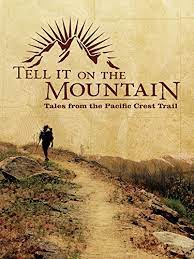 “Tell It on the Mountain” is a gripping and thought-provoking hiking movie that explores the transformative power of mountains and the human spirit. Directed by an acclaimed mountaineer and filmmaker, the film takes viewers on a thrilling journey as a group of mountaineers pushes their physical and mental limits to conquer some of the world’s most challenging peaks.
“Tell It on the Mountain” is a gripping and thought-provoking hiking movie that explores the transformative power of mountains and the human spirit. Directed by an acclaimed mountaineer and filmmaker, the film takes viewers on a thrilling journey as a group of mountaineers pushes their physical and mental limits to conquer some of the world’s most challenging peaks.
The movie introduces us to a diverse group of climbers, each with their unique motivations and backgrounds, as they embark on an expedition to summit towering mountains. Through breathtaking cinematography and immersive storytelling, “Tell It on the Mountain” transports viewers to the majestic landscapes where the climbers test their skills, endurance, and determination.
As the climbers face treacherous terrains, unpredictable weather conditions, and the constant risk of avalanches, the film captures the raw emotions and adrenaline of their mountainous pursuits. It showcases the awe-inspiring beauty of the peaks and the physical and mental challenges that climbers encounter on their ascent. Through the film’s visuals, viewers gain a profound appreciation for the grandeur and power of mountains.
“Tell It on the Mountain” delves into the personal stories and motivations of the climbers, revealing their fears, triumphs, and moments of self-discovery. It explores the psychological and emotional aspects of mountaineering, touching on themes of perseverance, teamwork, and the pursuit of personal growth. The film portrays the transformative impact of the mountains on the climbers’ lives, as they confront their own limitations and find strength and inspiration in the face of adversity.
Beyond the individual narratives, the movie also explores the interconnectedness between humans and nature. It highlights the importance of environmental stewardship and the need to preserve these majestic mountain environments for future generations. The film serves as a reminder of the fragile balance between humans and the natural world, emphasizing the responsibility we have to protect these awe-inspiring landscapes.
“Tell It on the Mountain” is not only a thrilling adventure film but also a reflection on the human spirit’s resilience and capacity for exploration. It showcases the power of mountains to challenge and inspire, inviting viewers to ponder their own personal mountains—physical, mental, or emotional—and the heights they can reach through determination and perseverance.
Key Takeaways:
- “Tell It on the Mountain” follows a group of climbers as they tackle challenging peaks around the world.
- The film captures the breathtaking beauty of mountains and the physical and mental challenges of mountaineering.
- It explores themes of perseverance, personal growth, and the interconnection between humans and nature.
- “Tell It on the Mountain” highlights the need for environmental stewardship and the preservation of these majestic landscapes.
- The movie inspires viewers to embrace their own personal mountains and strive for personal growth and exploration.
Buy “Tell it on the Mountain” via Prime Video
127 Hours
 “127 Hours” is an intense and harrowing hiking movie based on the true story of Aron Ralston, a seasoned adventurer who finds himself trapped in a remote Utah canyon after a boulder pins his arm. Directed by Danny Boyle, the film explores themes of survival, resilience, and the indomitable human spirit in the face of extreme adversity.
“127 Hours” is an intense and harrowing hiking movie based on the true story of Aron Ralston, a seasoned adventurer who finds himself trapped in a remote Utah canyon after a boulder pins his arm. Directed by Danny Boyle, the film explores themes of survival, resilience, and the indomitable human spirit in the face of extreme adversity.
The movie introduces us to Aron Ralston, portrayed by James Franco, as he embarks on a solo canyoneering trip in Utah’s Blue John Canyon. However, his excursion takes a fateful turn when a massive boulder dislodges and traps him in a narrow crevice, leaving him stranded and facing a life-or-death situation.
“127 Hours” takes viewers on an emotional rollercoaster as it vividly depicts Ralston’s struggle to free himself from the confines of the canyon. The film brilliantly captures the physical and psychological toll of his ordeal, immersing viewers in his claustrophobic and desperate predicament. Through powerful performances and compelling storytelling, the movie elicits a range of emotions, from fear and despair to hope and triumph.
Ralston’s harrowing experience becomes a catalyst for self-reflection and introspection. As he confronts his mortality and the reality of his situation, the film delves into his past, revealing his thirst for adventure, his regrets, and the relationships he holds dear. It showcases the inner strength and resilience that Ralston summons to overcome his physical and emotional challenges, ultimately leading to an extraordinary act of self-preservation.
“127 Hours” also explores the transformative power of human connections. In his isolated and desperate state, Ralston reflects on the importance of his loved ones and the value of human connection. The film serves as a poignant reminder of the significance of relationships and the resilience that can be found through the support and love of others.
Beyond the personal narrative, the movie highlights the unforgiving nature of the wilderness and the need for preparedness and caution when exploring remote areas. It serves as a cautionary tale, reminding viewers of the importance of responsible outdoor adventure and the potential consequences of underestimating the risks.
In summary, “127 Hours” is a gripping and emotionally charged hiking movie that explores the human will to survive in the face of extreme circumstances. It depicts Aron Ralston’s harrowing experience with authenticity and intensity, capturing the essence of his physical and emotional journey. The film serves as a testament to the resilience of the human spirit and the profound impact that even the most challenging situations can have on personal growth and self-discovery.
Key Takeaways:
- “127 Hours” is based on the true story of Aron Ralston, who becomes trapped in a remote Utah canyon.
- The film depicts Ralston’s physical and psychological struggle to survive and free himself from his predicament.
- It explores themes of survival, resilience, and the transformative power of human connections.
- “127 Hours” emphasizes the importance of responsible outdoor adventure and preparedness.
- The movie serves as a testament to the indomitable human spirit and the potential for personal growth in the face of extreme adversity.
Rent or Buy “127 Hours” via Prime Video
Appalachian Impressions
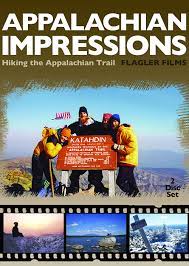 “Appalachian Impressions” is a captivating and immersive hiking movie that takes viewers on a cinematic journey through the picturesque landscapes of the Appalachian Trail. Directed by Scott Duncan, the film showcases the beauty and diversity of this iconic long-distance trail, highlighting the experiences of hikers who embark on this remarkable adventure.
“Appalachian Impressions” is a captivating and immersive hiking movie that takes viewers on a cinematic journey through the picturesque landscapes of the Appalachian Trail. Directed by Scott Duncan, the film showcases the beauty and diversity of this iconic long-distance trail, highlighting the experiences of hikers who embark on this remarkable adventure.
The movie opens a window into the Appalachian Trail, a 2,200-mile footpath that winds through the eastern United States, passing through majestic mountains, lush forests, and charming trail towns. Through stunning cinematography and evocative storytelling, “Appalachian Impressions” captures the essence of the trail, providing viewers with a sense of the awe-inspiring beauty and the challenges that await those who dare to hike it.
The film introduces a cast of hikers, each with their own motivations and aspirations for taking on the Appalachian Trail. It explores their personal journeys, from the initial excitement and anticipation to the physical and mental endurance required to complete such an arduous trek. Through interviews and footage along the trail, viewers gain insight into the transformative power of the Appalachian Trail and its impact on the lives of those who undertake the journey.
“Appalachian Impressions” goes beyond showcasing the natural beauty of the trail; it delves into the cultural and historical significance of the Appalachian region. The movie highlights the deep connection between hikers and the trail’s rich heritage, including stories of indigenous peoples, early settlers, and the preservation efforts that have allowed this natural wonder to endure. It fosters an appreciation for the diverse ecosystems and the importance of preserving the Appalachian Trail for future generations.
The documentary also examines the sense of community that emerges among hikers along the trail. It celebrates the bonds formed, the camaraderie shared, and the support hikers offer one another as they navigate the physical and emotional challenges of the journey. The film portrays the Appalachian Trail as a space that fosters a sense of belonging and unity among those who venture into its wilderness.
In summary, “Appalachian Impressions” is a visually stunning hiking movie that immerses viewers in the breathtaking landscapes and rich experiences of the Appalachian Trail. It captures the physical and emotional journeys of hikers, while also exploring the cultural and historical significance of the trail. The film inspires viewers to appreciate the beauty of the natural world, embrace the challenges of the trail, and foster a sense of community and stewardship for this treasured wilderness.
Key Takeaways:
- “Appalachian Impressions” showcases the beauty and diversity of the Appalachian Trail.
- The film captures the personal journeys of hikers and the transformative power of the trail.
- It explores the cultural and historical significance of the Appalachian region and the trail’s heritage.
- “Appalachian Impressions” celebrates the sense of community and camaraderie among hikers.
- The movie inspires viewers to appreciate and preserve the natural beauty of the Appalachian Trail.
Only the Essential
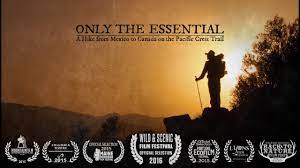 “Only the Essential” is a thought-provoking and introspective hiking movie that follows the transformative journey of a couple as they embark on a thru-hike of the Pacific Crest Trail (PCT). The film explores the profound impact of long-distance hiking on the human spirit and the pursuit of a simpler, more intentional way of life.
“Only the Essential” is a thought-provoking and introspective hiking movie that follows the transformative journey of a couple as they embark on a thru-hike of the Pacific Crest Trail (PCT). The film explores the profound impact of long-distance hiking on the human spirit and the pursuit of a simpler, more intentional way of life.
The movie introduces viewers to the couple, who decide to leave behind their conventional lives and embark on a life-changing adventure along the PCT. As they navigate the rugged terrain, the film captures their physical challenges, emotional growth, and the profound connections they form with nature and themselves.
“Only the Essential” delves into the concept of minimalism and the idea of stripping away the non-essential aspects of life. The film highlights the transformative power of simplifying one’s belongings and focusing on what truly matters. Through the lens of the PCT hike, it prompts viewers to reflect on their own lives and the value of embracing simplicity and mindfulness.
The documentary also explores the unique sense of community that develops among long-distance hikers. It showcases the camaraderie, mutual support, and shared experiences that arise as hikers traverse the trail together. The film captures the relationships formed along the journey, emphasizing the importance of human connection and the shared love for the outdoors.
“Only the Essential” immerses viewers in the stunning landscapes of the Pacific Crest Trail. It showcases the diversity of the trail, from desert vistas to snow-capped peaks, and provides a glimpse into the challenges and rewards of hiking long distances. The film captures the awe-inspiring beauty of the natural world and the resiliency required to navigate through it.
Moreover, “Only the Essential” delves into the internal transformations experienced by the hikers. It explores the introspective moments, the personal growth, and the newfound perspectives that arise as they disconnect from the noise of modern society and immerse themselves in the simplicity and solitude of the trail.
In summary, “Only the Essential” is a captivating and reflective hiking movie that invites viewers to contemplate the power of minimalism, the importance of human connection, and the transformative nature of long-distance hiking. It encourages viewers to reconsider their own lives, embrace simplicity, and cultivate a deeper connection with nature and themselves.
Key Takeaways:
- “Only the Essential” follows the transformative journey of a couple thru-hiking the Pacific Crest Trail.
- The film explores the concept of minimalism and the value of simplifying one’s life.
- It showcases the sense of community and shared experiences among long-distance hikers.
- The documentary captures the stunning landscapes and challenges of the Pacific Crest Trail.
- “Only the Essential” delves into the personal growth and introspective moments experienced on the trail.
- It encourages viewers to reflect on their own lives, embrace simplicity, and deepen their connection with nature.
Southbounders
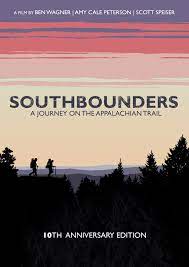 “Southbounders” is an inspiring hiking movie that follows the journey of a young woman who embarks on a southbound thru-hike of the Appalachian Trail (AT). The film offers a unique perspective on the challenges, triumphs, and personal growth that unfold along this iconic long-distance hiking trail.
“Southbounders” is an inspiring hiking movie that follows the journey of a young woman who embarks on a southbound thru-hike of the Appalachian Trail (AT). The film offers a unique perspective on the challenges, triumphs, and personal growth that unfold along this iconic long-distance hiking trail.
The movie introduces viewers to the protagonist, who decides to leave behind her comfortable life and venture into the wilderness to tackle the Appalachian Trail from north to south. As she sets foot on the trail, the film captures the physical demands, mental fortitude, and emotional roller coaster that she experiences throughout her journey.
“Southbounders” explores the physical challenges faced by thru-hikers on the Appalachian Trail. It portrays the grueling climbs, rocky terrain, and unpredictable weather conditions that test the limits of endurance. Through stunning visuals and immersive storytelling, the film provides a sense of the trail’s magnitude and the sheer determination required to complete it.
Beyond the physical aspects, “Southbounders” delves into the psychological and emotional transformation that occurs during a thru-hike. The film captures the solitude, self-reflection, and moments of self-discovery that the protagonist encounters as she navigates the trail. It explores the internal battles, personal growth, and newfound perspectives that emerge through the arduous yet rewarding journey.
The documentary also showcases the vibrant trail community that develops along the Appalachian Trail. It highlights the friendships, shared experiences, and support networks that hikers form as they cross paths and bond over their shared love for the trail. The film emphasizes the sense of camaraderie and the profound connections that arise among fellow hikers.
“Southbounders” immerses viewers in the beauty of the Appalachian Trail’s natural surroundings. It captures the ever-changing landscapes, from lush forests to breathtaking mountain vistas, and showcases the diverse flora and fauna encountered along the way. The film instills a deep appreciation for the unspoiled wilderness and the need to protect and preserve these precious environments.
Moreover, “Southbounders” presents a compelling narrative of self-discovery and personal empowerment. It portrays the protagonist’s journey of overcoming obstacles, finding inner strength, and embracing the freedom that comes from living in harmony with nature. The film inspires viewers to pursue their own dreams, step outside their comfort zones, and embrace the transformative power of outdoor adventures.
In summary, “Southbounders” is a captivating hiking movie that provides a glimpse into the physical, emotional, and psychological challenges of thru-hiking the Appalachian Trail. It celebrates the beauty of the natural world, the sense of community along the trail, and the personal growth that emerges from embracing a life of adventure and self-discovery.
Key Takeaways:
- “Southbounders” follows a young woman on her southbound thru-hike of the Appalachian Trail.
- The film captures the physical challenges and stunning landscapes of the trail.
- It explores the psychological and emotional transformation that occurs during a thru-hike.
- The documentary showcases the vibrant trail community and the friendships formed along the way.
- “Southbounders” inspires viewers to embrace outdoor adventures and pursue personal growth.
- The film highlights the need to protect and preserve our natural environments for future generations.
Edie
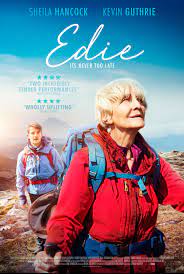 “Edie” is an inspiring and empowering hiking movie that celebrates the spirit of adventure, personal growth, and the pursuit of dreams at any age. Directed by Simon Hunter, the film tells the story of Edith Moore, an octogenarian who embarks on a life-changing journey to fulfill her long-held dream of climbing Mount Suilven in the Scottish Highlands.
“Edie” is an inspiring and empowering hiking movie that celebrates the spirit of adventure, personal growth, and the pursuit of dreams at any age. Directed by Simon Hunter, the film tells the story of Edith Moore, an octogenarian who embarks on a life-changing journey to fulfill her long-held dream of climbing Mount Suilven in the Scottish Highlands.
The movie introduces viewers to Edie, a spirited and determined woman who has spent most of her life caring for her ailing husband. Following his passing, Edie feels a newfound sense of freedom and embarks on an unconventional quest to conquer the challenging mountain peak. With little experience and against the odds, she sets out on an adventure that will push her physical and mental boundaries.
“Edie” captures the essence of resilience and the human spirit as Edie navigates the demanding terrain of the Scottish Highlands. The film showcases the breathtaking landscapes, from rugged mountains to serene valleys, immersing viewers in the beauty of the natural world. It highlights the transformative power of nature and the cathartic effect of immersing oneself in the wilderness.
The documentary explores the personal growth and self-discovery that Edie experiences during her journey. Through the physical challenges and emotional hurdles she encounters, she learns to trust her abilities, confront her fears, and embrace the freedom that comes with stepping outside her comfort zone. “Edie” serves as a reminder that it is never too late to pursue one’s dreams and live life to the fullest.
“Edie” also highlights the importance of human connections in our pursuit of happiness. Along her journey, Edie forms a heartwarming bond with Jonny, a young guide who helps her navigate the mountain. Their intergenerational friendship brings joy, companionship, and a sense of camaraderie that transcends age and background. The film emphasizes the power of shared experiences and the impact of genuine connections.
Moreover, “Edie” celebrates the strength and resilience of older adults, challenging stereotypes and societal expectations. The movie shines a spotlight on the vitality, wisdom, and determination that can be found in individuals of all ages. It encourages viewers to embrace their passions, overcome obstacles, and seize opportunities for personal growth, regardless of age or circumstances.
In summary, “Edie” is a heartwarming hiking movie that portrays the transformative journey of an octogenarian pursuing her dreams. It inspires viewers to embrace adventure, overcome challenges, and find personal fulfillment through the power of nature and human connections. The film serves as a reminder that age is not a barrier to living a life filled with passion, purpose, and joy.
Key Takeaways:
- “Edie” follows the journey of an octogenarian as she sets out to conquer Mount Suilven.
- The film captures the beauty of the Scottish Highlands and the transformative power of nature.
- It explores personal growth, self-discovery, and the courage to pursue dreams at any age.
- “Edie” emphasizes the importance of human connections and intergenerational friendships.
- The documentary challenges stereotypes about older adults and celebrates their resilience and vitality.
- It inspires viewers to embrace adventure, overcome obstacles, and live life to the fullest.
Watch “Edie” Now with Prime Video
It is the People
 “It is the People” is a heartwarming and insightful hiking movie that goes beyond the exploration of trails and mountains to focus on the transformative power of human connections. The film takes viewers on a journey of self-discovery and community as it explores the lives and stories of hikers from diverse backgrounds who come together on the trails.
“It is the People” is a heartwarming and insightful hiking movie that goes beyond the exploration of trails and mountains to focus on the transformative power of human connections. The film takes viewers on a journey of self-discovery and community as it explores the lives and stories of hikers from diverse backgrounds who come together on the trails.
This hiking movie introduces viewers to a group of individuals who embark on a hiking adventure, each with their own unique motivations and life experiences. As they traverse the picturesque landscapes and face the physical challenges of the trail, they forge deep connections, share personal stories, and support one another in unexpected ways.
“It is the People” captures the essence of human connections and the profound impact they can have on personal growth and emotional well-being. The film emphasizes that the true magic of hiking lies not only in the majestic beauty of nature but also in the shared experiences, conversations, and camaraderie that are fostered along the way. It celebrates the power of compassion, empathy, and genuine human connections.
Through intimate interviews and personal narratives, “It is the People” explores the diverse backgrounds and motivations of the hikers. It sheds light on the challenges they have overcome, the dreams they are pursuing, and the lessons they have learned through their hiking journeys. The film reveals the universal themes of resilience, self-discovery, and the pursuit of inner peace that unite hikers from all walks of life.
The documentary also touches upon the concept of hiking as a metaphor for life. It draws parallels between the physical challenges of the trail and the obstacles we face in our personal journeys. It highlights the importance of perseverance, adaptability, and embracing the present moment as key lessons that can be learned from the hiking experience.
Moreover, “It is the People” underscores the power of community and the support networks that develop among hikers. The film showcases the compassion, encouragement, and sense of belonging that emerge when individuals come together with a shared passion for nature and adventure. It reminds viewers of the significance of surrounding oneself with positive and supportive people who uplift and inspire.
In summary, “It is the People” is a compelling hiking movie that goes beyond the trails to highlight the transformative power of human connections. It celebrates the diversity of hikers’ backgrounds and motivations while emphasizing the universal themes of resilience, self-discovery, and community. The film inspires viewers to embrace the beauty of nature, foster meaningful connections, and recognize the importance of supporting and uplifting one another on life’s journey.
Key Takeaways:
- “It is the People” explores the transformative power of human connections in the hiking experience.
- The film highlights the shared experiences, conversations, and support among hikers from diverse backgrounds.
- It celebrates the power of compassion, empathy, and genuine human connections.
- “It is the People” reveals the universal themes of resilience, self-discovery, and the pursuit of inner peace.
- The documentary draws parallels between hiking and life’s challenges, emphasizing perseverance and adaptability.
- It underscores the importance of community and the positive impact of supportive networks.
- The film inspires viewers to embrace nature, foster meaningful connections, and uplift one another on life’s journey.
Hiking Movies: The Bottom Line
From the gripping true story of Chris McCandless in “Into the Wild” to the soul-stirring journey of Cheryl Strayed in “Wild,” these hiking movies transport us to breathtaking landscapes and invite us to embark on personal journeys of self-discovery and resilience. Each movie offers its own unique perspective on the power of nature, the importance of human connections, and the triumph of the human spirit.
We explored the thrilling and perilous adventures in films like “127 Hours” and “The Way Back” where individuals are pushed to their physical and mental limits, showcasing the indomitable human will to survive and overcome extraordinary challenges. These hiking movies remind us of the strength that lies within us and the courage needed to face the unknown.
We also delved into films like “Tracks,” “Wildlike,” and “A Walk in the Woods,” which emphasize the personal growth and introspection that can be found on the hiking trail. These hiking movies demonstrate that sometimes the greatest journeys are those that take place within ourselves, as we confront our fears, discover our true identities, and find solace and healing in the embrace of nature.
It is clear that these films hold the power to ignite our sense of adventure, spark introspection, and remind us of the remarkable beauty and resilience of the human spirit. Whether you are an avid hiker, an outdoor enthusiast, or simply someone seeking inspiration and captivating storytelling, these hiking movies have something profound to offer. If you have the chance to watch one of the hiking films on our list, allow yourself to be immersed in the power of storytelling and the transformative experiences that await you on the trails.
Remember, the world is full of extraordinary adventures, and these hiking movies serve as a reminder that sometimes all we need is the courage to take that first step. So, go forth, explore, and create your own trailblazing tales.
Happy movie-watching!
Looking to get started on your own hiking adventure? Check out 5 Reasons Hiking is a Fun and Fulfilling Adventure



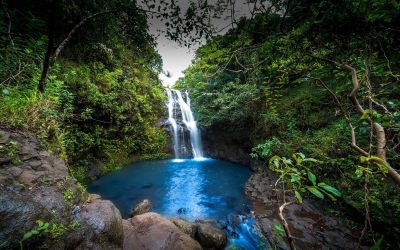





Leave a Reply